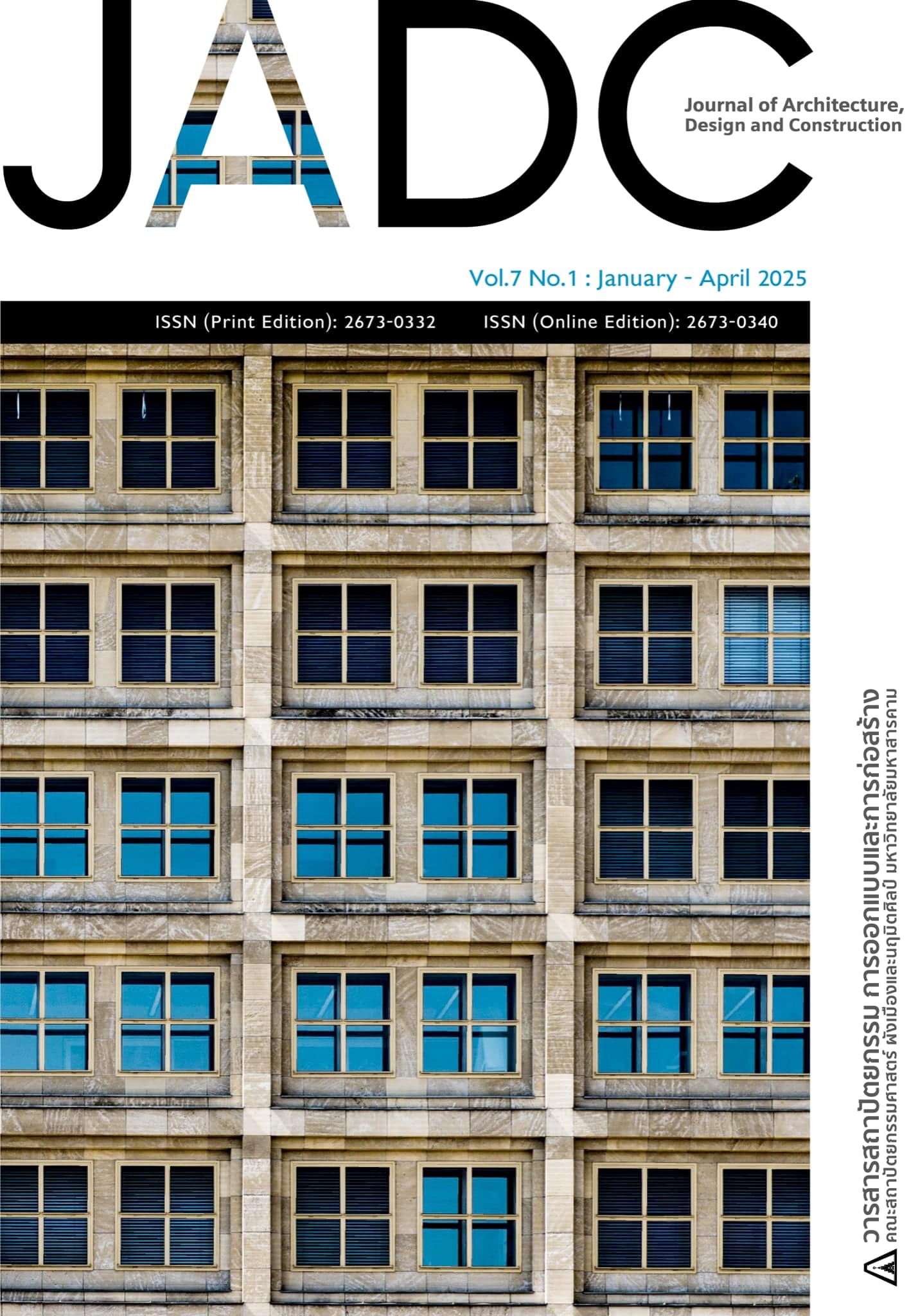Learning Space for Libraries in the 21st Century: Perspectives from the Center for Library Resources and Educational Media, Walailak University
Main Article Content
บทคัดย่อ
This study aimed to explore the need for collaborative spaces in libraries and provide practical guidelines for their design and usage. Data were collected from 17 interviewees and 168 survey respondents who shared perspectives on enhancing 21st-century skills. Based on the findings, the study proposed recommendations for designing shared spaces in libraries, including meeting rooms, group work areas, computer desktop zones, and service points for snacks and beverages. Three key design principles emerged: zoning, flexibility, and creating a creative environment. These principles offer a comprehensive framework for designing collaborative spaces that meet diverse needs and foster active, engaged learning. Libraries are evolving into vibrant learning environments, and these guidelines provide valuable insights for designing collaborative spaces that cater to evolving demands. The recommended design elements include meeting rooms, group work areas, computer desktop zones, and service points for snacks and beverages. The design principles emphasize clear spatial separation, flexibility, and fostering a creative environment. Implementing these suggestions transforms libraries into hubs of collaboration and active learning. This research provides valuable insights and recommendations for designing collaborative spaces in libraries, enabling them to play a crucial role in supporting learning and skill development for users. Libraries should adapt to meet evolving needs, with an emphasis on creating spaces that foster collaboration and creativity, including diverse areas, and designated zones for quiet and privacy. Continuously enhancing these spaces will help libraries stay current and responsive to evolving user needs.
Downloads
Article Details

อนุญาตภายใต้เงื่อนไข Creative Commons Attribution-NonCommercial-NoDerivatives 4.0 International License.
บทความที่ได้รับการตีพิมพ์เป็นลิขสิทธิ์ของวารสารสถาปัตยกรรม การออกแบบและการก่อสร้าง คณะสถาปัตยกรรมศาสตร์ ผังเมืองและนฤมิตศิลป์ มหาวิทยาลัยมหาสารคาม
เอกสารอ้างอิง
Abbasi, N., Richard, T., Kenn, F., & Robert, G. (2014). Library spaces designed with students in mind: An evaluation study of University of Queensland libraries at St Lucia campus. In Proceedings of the IATUL Conferences. Purdue University. https://docs.lib.purdue.edu/iatul/2014
Anagun, S. (2018). Teachers’ perceptions about the relationship between 21st century skills and managing constructivist learning environments. International Journal of Instruction, 11(4), 825–840. https://doi.org/10.12973/iji.2018.11452ad
Dos Santos, L. M. (2023). The relationship between environmental, outdoor and field education: A study in rural communities. International Journal of Instruction, 16(1), 643–658. https://doi.org/10.29333/iji.2023.16136a
Dziuban, C. D., Moskal, P. M., & Hartman, J. (2004). Higher education, blended learning, and the generations: Knowledge is power—No more. University of Central Florida. https://desarrollodocente.uc.cl/wpcontent/uploads/2020/03/Knowledge_is_power_no_more.pdf
Ellison, W. (2016). Designing the learning spaces of a university library. New Library World, 117(5/6), 294–307. https://doi.org/10.1108/NLW-01-2016-0006
Goldman, E., Phillips, M., Riel, C., Shamberger, J., & Turek, C. (2009). Learning in a chaotic environment. Journal of Workplace Learning, 21(7), 555–574. https://doi.org/10.1108/13665620910985540
Grigsby, S. K. S. (2015). Re-imagining the 21st century school library: From storage space to active learning space. TechTrends, 59(2), 103–106. https://doi.org/10.1007/s11528-015-0859-5
Hartman, J., Moskal, P. M., & Dziuban, C. D. (2005). Preparing the academy of today for the learner of tomorrow. Educating the Net Generation. https://www.educause.edu/research-and-publications
Head, A. J. (2016). Planning and designing academic library learning spaces: Expert perspectives of architects, librarians, and library consultants. https://files.eric.ed.gov/fulltext/ED571288.pdf
Howard, E. (2010). To-morrow: A peaceful path to real reform. Cambridge University Press.
John, G. (2016). Designing libraries in 21st century. British Council.
Karakas, F., Manisaligil, A., & Sarigollu, E. (2015). Management learning at the speed of life: Designing reflective, creative, and collaborative spaces for millennials. The International Journal of Management Education, 13(3), 237–248. https://doi.org/10.1016/j.ijme.2015.07.001
Laura, R. S., Mitchel, T., & Smith, S. (2008). The new social disease: From high tech depersonalization to survival of the soul. University Press of America.
Lichtenfeld, S., Elliot, A. J., Maier, M. A., & Pekrun, R. (2012). Fertile green: Green facilitates creative performance. Personality and Social Psychology Bulletin, 38(6), 784–797. https://doi.org/10.1177/0146167212436611
McCosker, A., & Wilken, R. (2012). Café space, communication, creativity, and materialism. M/C Journal, 15(2). https://doi.org/10.5204/mcj.459
McDonald, A. (2006). The ten commandments revisited: The qualities of good library space. LIBER Quarterly, 16(2). https://doi.org/10.18352/lq.7840
Michalak, R., & Rysavy, M. D. T. (2023). Fostering change to bolster student success: Renovating the library and reducing stacks to create communal collaborative space. Journal of Library Administration, 63(3), 371–385. https://doi.org/10.1080/01930826.2023.2177927
Ozburn, L., Kane, J., & Elliott, T. (2020). Creating collaborative library spaces through partnerships with campus organizations. Journal of Library Administration, 60(6), 600–612. https://doi.org/10.1080/01930826.2020.1748432
Pearlman, B. (2010). Designing new learning environment to support 21st century skills. In J. A. Bellanca & R. S. Brandt (Eds.), 21st century skills: Rethinking how students learn (pp. 116–147). Solution Tree Press. http://dspace.vnbrims.org:13000
Ramsey, V. J., & Fitzgibbons, D. E. (2005). Being in the classroom. Journal of Management Education, 29(2), 333–356. https://doi.org/10.1177/105256290427114
Santos, I. M., Ali, N., & Hill, A. (2016). Students as co-designers of a virtual learning commons: Results of a collaborative action research study. The Journal of Academic Librarianship, 42(1), 8–14. https://doi.org/10.1016/j.acalib.2015.09.006
Seal, R. A. (2015). Library spaces in the 21st century: Meeting the challenges of user needs for information, technology, and expertise. Library Management, 36(8/9), 558–569. https://doi.org/10.1108/LM-11-20140136
Tapscott, D. (2008). Grown up digital. McGraw-Hill Education.
Thoring, K., Mueller, R. M., Desmet, P., & Badke-Schaub, P. (2018). Design principles for creative spaces. In Proceedings of the DESIGN 2018 15th International Design Conference, (pp. 1969–1980). Design Society.
Yu, T. X., Mokhtar, W. M., & Md Ruzanna, M. (2019). Integration of 21st century learning skills (4C elements) in interventions to improve English writing skill among 3K class students. International Journal of Contemporary Education, 2(2), 100. https://doi.org/10.11114/ijce.v2i2.4498
Yudhawasthi, C. M., & Chua, L. (2021). Challenges of higher educational documentary institutions in supporting Merdeka Belajar Kampus Merdeka program. Khazanah al Hikmah: Journal Ilmu Perpustakaan Dan Kearsipan, 9(2). https://doi.org/10.24252/kah.v9cf2


